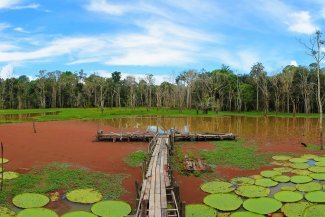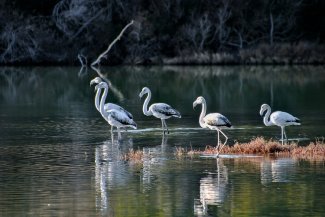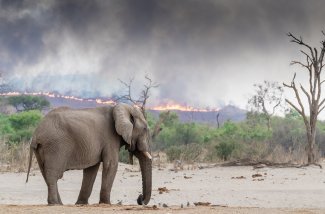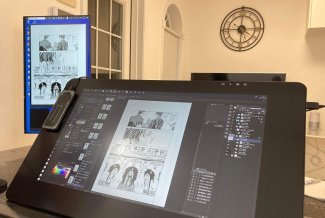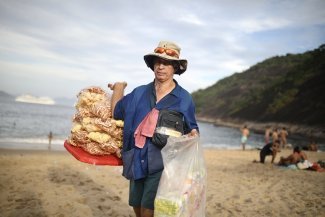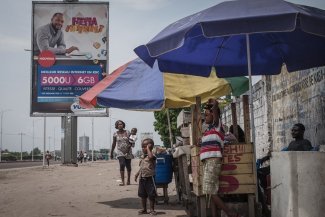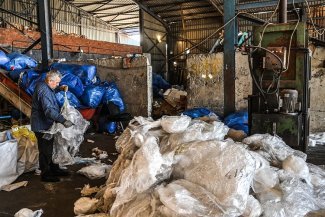“They say it will create jobs for fishermen. But fishermen don’t want jobs in the hotel industry. Fishermen want a clean and healthy lagoon,” says Vilson Francisco Correa, a fisherman and chair of the ACCLAPEZ association opposed to the development of a resort in the Maricá restinga.
Overflown by butterflies, scrub vegetation thrives on this eight-kilometre-long unspoilt beach nestled between the sea and the lagoon. The restinga of Maricá, just over an hour’s drive from Rio de Janeiro in Brazil, is a habitat with unique biodiversity – already described by Charles Darwin in the 19th century in the notebooks of his voyage to the Americas. On 6 April 2023, the soundtrack to this heavenly setting began to crackle. For over a month, the usual sound of rolling waves was accompanied by the to-and-fro of construction machinery along the coastal path. A luxury resort, designed by the Spanish company IDB Brazil, could be erected there by 2026.
The master plan for ‘Maraey’ not only includes hotels and residential buildings, but also a shopping complex, a conference centre, an equestrian club, an aquarium and a golf course. According to the estimates of the Maricá Restinga Researchers’ Forum, the development could draw up to 300,000 visitors a year, or as many as 8,000 cars a day.
While the advertising boards planted in the middle of the dunes promote it as “the best sustainable tourist and residential destination in the Americas”, many researchers and environmental associations, whose conservation campaign began some 15 years ago, are warning of the threat to local biodiversity.
The site is part of the Mata Atlântica or Atlantic Forest, a tropical rainforest declared a biosphere reserve by UNESCO, stretching from the Brazilian coast to northern Argentina. It is one of Brazil’s most extensively studied restingas (the term used to describe this type of sandbar covered in vegetation influenced by the marine environment). “It is one of the rare remnants of this ecosystem associated with the Atlantic Forest in the state of Rio de Janeiro,” explains Anderson dos Santos Portugal, a biologist and professor at Rio de Janeiro State University (UERJ).
According to botanist Ana Angélica Barros, who also teaches at UERJ, at least fifteen plant and animal species found in this restinga are threatened with extinction in Brazil. Among them are the beach butterfly, the sand lizard and the cloud fish, whose poetic name comes from the way it reproduces. The vertebrate procreates in flooded areas where the water then evaporates leaving the eggs buried in the sediment on the ground. They hatch when the next rains arrive.
“That’s why they’re called cloud fish, as if they descended from the sky when it rains,” says the researcher. Biologist Jorge Antônio Lourenço Pontes from the City of Rio de Janeiro’s Environment Secretariat explains that these species are all “endemic to the state of Rio de Janeiro” and “the Maricá restinga is one of their last remaining refuges”.
Species such as the local green-tailed lizard or the eugenia maricaensis (a plant named after Maricá) do not exist anywhere else in the world, according to Santos Portugal. “The extinction of species is absurd,” insists Barros. “Genetic strains that have evolved over thousands of years will be lost forever, leading to the extinction of other species. And for what? To build a resort?” For geographer Désirée Guichard Freire, a lecturer and researcher at UERJ and a member of the Pro-Restinga Movement, the erection of buildings could also damage the natural barrier that the beach forms against coastal erosion.
The company, for its part, claims to have drawn up “an extensive inventory of the local flora and fauna” in conjunction with researchers before launching the project. “Only 6.6 per cent of the area will be occupied by buildings,” says IDB Brazil, and “81 per cent of the Maraey area will be preserved or reclaimed with vegetation native to the restinga and the Atlantic Forest”. It even says it wants to create a “private natural heritage reserve”.
A polluted lagoon
The threat to endemic species is not the only environmental concern. A fishing community, settled in the area since the 18th century, practises traditional fishing in the adjacent lagoon. The calm waters, surrounded by the blue line of distant hills, are home to mullet, sea bass and tilapia.
On the shore, busy folding his nets and cleaning his boat after a night’s fishing that began at 11pm, Sergio da Rocha reminisces: “Thirty years ago, this lagoon was crystal clear. You could see schools of fish turning purple. At night, it was as silvery as the sea.” The sixty-year-old, born and bred on the shores of the lagoon, sighs: “The lagoon of today is no longer the same.”
The problem, according to him and other members of the Cultural and Leisure Association of the Zacarias Fishing Community (ACCLAPEZ), is the discharge of wastewater from the nearby apartment blocks. And although the company claims that “all the wastewater from the project will go through a tertiary treatment plant”, Vilson Francisco Correa, the association’s chair, fears that the proposed tourism complex could add to the pollution of the lagoon.
“They say it will create jobs for fishermen. But fishermen don’t want jobs in the hospitality industry. Can you imagine a fisherman on a golf course? Golf is for millionaires, for people with money. Fishermen want a healthy, clean lagoon. It’s our livelihood.”
A few kilometres down, on the other side of the lake, a sandy road leads to several dozen adobe houses with thatched roofs. This Indigenous village, aldeia Mata Verde Bonita, which has been located in the middle of the reserve for the last ten years or so, has also taken up this ecological issue. Sitting on the first floor of the community institute, sweeping his gaze over the river, Tupã Darci Nunes, one of the leaders of the community’s 180 inhabitants, solemnly observes: “We, the Indigenous peoples, have our own way of working with the land, without destroying it. We feel as if we’ve been invaded. Our rights have been violated, because we are the ones who live in the restinga, not them.”
IDB Brazil’s plan is to create a tourist village complete with an Indigenous themed hotel, to ‘value’ the culture of the Guarani ethnic group. To accomplish this, existing buildings in the village would have to be demolished and the banks of the river developed. Tupã Darci Nunes is resigned to talking to the company. “Economic power rules the roost,” decries Nunes who, just a few weeks prior, had stood in the way of the construction machinery along with other members of the community.
What he still regrets is the lack of dialogue. “If they want the village to be like a zoo that’s visited every day, it will turn into something very commercial. And we don’t want to convey that image. We don’t want to lose our roots, our way of praying, of harvesting food from the fields, our culinary traditions, because that’s how we’ll live happily, by conveying what we are.” The Indigenous leader also disapproves of the company’s use of the Guaraní word Maraey, meaning ‘land without evil’, as the name of the development. “The term is so sacred that even the young people of the village don’t use it. Using it is highly offensive. To me, it’s like killing an Indigenous person, taking their sacred name and giving it to your company as the spoils.”
Temporary suspension
The reason those opposed to the resort have kept on fighting, despite the start of the works, is that the project is caught up in a legal dispute. The reserve has been an environmental protection site since 1984. But this does not exclude the right to build on it. “It’s a very permissive type of conservation unit that allows for built-up areas,” explains Désirée Guichard Freire, who has written extensively on this environmental dispute. The environmentalists maintain that the permits granted to the company by the state of Rio de Janeiro and the municipal council were approved despite the courts prohibiting any kind of development in the Maricá environmental protection area.
In mid-May, IDB Brazil, which has owned the land for ten years and is firmly backed by the municipal authorities, stated that “no court ruling (was preventing) development anywhere on the site”. Following this statement, on 26 May 2023, the Supreme Court of Justice ordered the suspension of the environmental licences granted to the company and the stoppage of works. This ‘emergency’ measure, aimed at preventing irreversible environmental damage, is provisional, as the company can appeal the decision.
Freire believes it is “unlikely the licences will be reinstated”, but other projects could threaten the restinga again in the future. Those campaigning to protect it are therefore calling for the creation of a nature park on the sandbank, “a conservation unit that would protect the entire ecosystem,” she explains. “Because the one currently in place leaves it vulnerable.”
“There are Europeans that are selling our history as if it were the most natural thing in the world,” denounces botanist Ana Angélica Barros. “They take control of our land, destroy our environment and wipe out our species to make money, and they want to leave it at that?”
At the end of May, a photo shared on the Instagram account of the group opposing the Maricá development project echoes these views. The photo shows ten vultures perched on top of one of the advertising boards installed by the company, sharply contrasting with the promotional image of deckchairs by the sea. The graffiti, written in red in Portuguese, reads: “Colonisers Out”.




